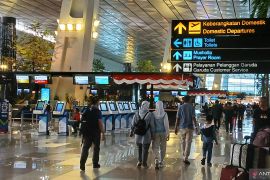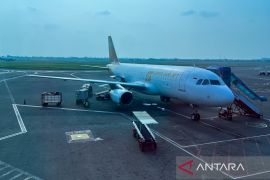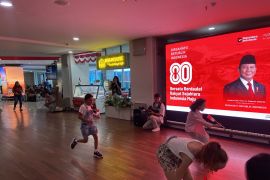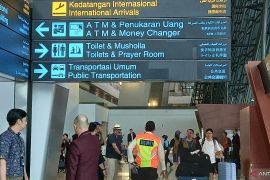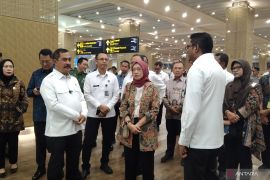The national aviation business is flourishing however the development is not in line with the conditions of airports in Indonesia where most of them are battling with overcrowding.Jakarta (Antara News) - A relatively positive economic growth in the past few years has impacted the national airline business, where the growth combined with cheap airline ticket prices have made more people use airways for intercity transport.
This year has seen an increase in domestic airline passengers by 20 percent from 63.6 million people in 2012 to 76.4 million people in 2013. International flights have also witnessed an increase in the number of passengers from 8.8 million people in 2012 to 9.7 million people this year.
The national aviation business is flourishing with airlines such as the flag carrier Garuda Indonesia, Lion Air, Sriwijaya Air and Indonesia Air Asia, sharing Indonesias 251 million market together.
Lion Air, for example, signed a last to buy 230 planes from the France-based company, Airbus. According to Lion Airs CEO Rusdi Kirana, the decision was made on the basis of a positive trend of growing number of passengers and economic growth in Indonesia and the Asia Pacific region.
However, the development is not in line with the conditions of airports in Indonesia where most of them are battling with overcrowding.
The Soekarno Hatta international airport, for example, receives 58 million passengers per year or double of its initial target of 22 million people per year.
Polonia airport, one of the busiest airports in Sumatra Island, accommodated 6.2 million passengers last year, which is more than 563 percent of its rated capacity of 1.1 million people a year. The high density in the airports causes several issues such as flight delays, long queues in the ticket and immigration counters, and so on.
Other airports which run beyond their capacities, as quoted by the Tempo Daily, are Ngurah Rai airport (Bali province), Juanda (East Java), Sultan Hasanuddin (South Sulawesi), Sepinggan (East Kalimantan), Adisutjipto (Yogyakarta), Syamsudin Noor (South Kalimantan), Ahmad Yani (Central Java), El Tari (East Nusatenggara) and Frans Kaisiepo (Papua).
According to Chief of Research and Development Unit at Indonesias Transportation Ministry Nyoman Suanda Santra, the number of overcapacity ranges between 42 to 400 percent of the airports initial capacity targets.
Aviation business observer Samudra Sukardi emphasized the need for the government to overcome the airport overcapacity issue as soon as possible as it will otherwise have negative impacts on the national airline industry.
"Indonesia comprises of islands which makes airways the most effective modes of transport as it can support the flow of people and goods. The airline business cannot survive alone without the presence of adequate airports, strong regulations and good human resources that control air traffic," stated Samudra Sukardi, former Vice President of the national flag carrier Garuda Indonesia.
According to Samudra, up till now Garuda Indonesia is the only airline company which has produced qualified pilots and mechanics, even as the State Aviation Academy has not yet been able to produce the number of required qualified pilots and mechanics.
Meanwhile, former Chief of Staff of Indonesian Air Forces Chappy Hakim suggested that the government reduces the number of flights operating in these airports up to its initial target.
Chappy also recommended that the government adds more taxiways and aprons in the airports. He asked the related authority to improve the outdated equipments in the air traffic control office in order to ensure flight safety in Indonesia.
"Human resource is also another important factor in ensuring safety of flights. Pilots and officials operating air traffic control must be able to carry out their tasks well," Chappy added.
In response to the overcapacity issue, the government under Transportation Ministry has announced various policies such as expansion of airport area and establishment of new airports.
Currently the Soekarno-Hatta international airport management is conducting an expansion of the airports area including its taxiway, apron and an integrated domestic terminal.
The expansion of Soekarno-Hatta airport will cost around Rp 11.75 trillion for the first stage. Meanwhile, the Polonia airport in North Sumatra province is closed and is being replaced by the Kualanamu airport, which is capable of handling 8.1 million passengers each year.
Spread over an area of 1,365-hectares, the Kuala Namu airport will replace the Polonia International Airport in Medan, which has been operating over capacity. The Polonia airport accommodated 6.2 million passengers last year, more than 563 percent of its rated capacity of 1.1 million people a year.
Speaking on the plan to expand the existing airports areas, Tommy Soetomo, CEO of state-owned airport management PT Angkasa Pura, noted that it is still a challenging task due to the limited availability of land.
He referred to the Adisucipto airport of the Yogyakarta province, as an example, which currently serves up to 4.9 million passengers a year, and is thus in need of expansion, but has yet not been implemented.
"The study for the development of a new airport in Kulon Progo has already been completed, but cannot be implemented as yet due to land acquisition problems," he added.
Tommy also stated that land acquisition has so far been the main problem hindering extension programs as almost all airports, such as Adisucipto, are located alongside land belonging to the defense forces.
EDITED BY INE
(A051/INE/B003)
(T.A051/A/KR-BSR/B003) 23-12-2013 19:43:32
Reporter: By Amie Fenia Arimbi
Editor: Fardah Assegaf
Copyright © ANTARA 2013


